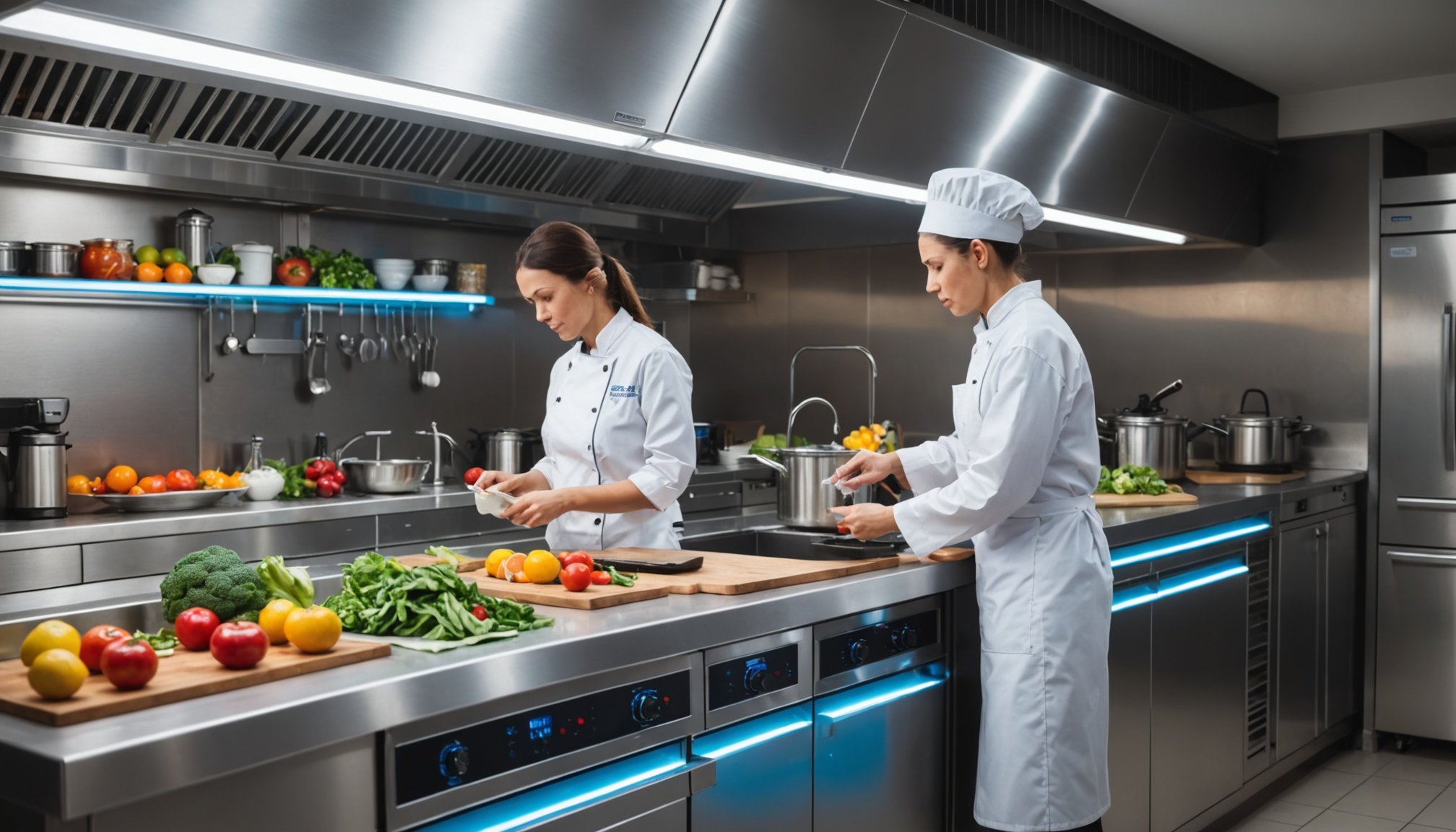Understanding UV Light Technology
UV light technology is pivotal in modern sanitization processes, especially in ensuring food safety. UV light is part of the electromagnetic spectrum, invisible to the human eye, that effectively reduces pathogens by disrupting their DNA. This disruption prevents their reproduction, significantly hindering the spread of bacteria and viruses.
There are three main types of UV light—UVA, UVB, and UVC—each with distinct characteristics and applications. UVC light is the most effective for sanitization purposes, capable of pathogen reduction in both air and surfaces. It’s widely used in kitchens and food processing environments to minimize contamination risks.
Also read : Maximizing your fridge: discover the keys to healthier eating and successful weight control
Scientific studies reinforce the effectiveness of UV light sanitizers. The rigorous research demonstrates that UVC light can kill up to 99.9% of germs, including E.coli and Listeria, prevalent in food preparation areas. It highlights its role in enhancing everyday food safety practices without resorting to harmful chemicals.
Incorporating UV light in kitchen appliances and food storage solutions provides an added layer of protection. For maximum effectiveness, ensure devices are used as directed, as exposure time and distance from surfaces are crucial factors. UV light technology thus offers a robust solution for maintaining a hygienic environment in food-related spaces.
Also to read : Elevate your health: how a multi-layered fruit basket can transform your kitchen and boost daily fruit servings
Impact of UV Light on Food Safety
Harnessing the power of UV light sanitizers has proven to be transformative in the realm of food safety. These devices significantly reduce foodborne pathogens and harmful bacteria, offering an efficient means of pathogen reduction. Unlike traditional methods that often rely on chemicals, UV light sanitizers employ a non-contact approach that minimizes contamination risk.
Extensive studies have demonstrated the effectiveness of UV light in curbing foodborne illness. For instance, a study found that UV-C irradiation could inactivate up to 99.9% of certain bacteria on produce surfaces, underscoring its capability to dramatically reduce microbial load. Such findings highlight the potential of UV light to lower food-related illnesses, providing a safer pathway from farm to table.
Comparisons between UV sanitization and traditional cleaning methods further accentuate the benefits of UV technology. While traditional cleaning utilizes physical scrubbing and chemical disinfectants, which may not reach all affected areas, UV sanitizers penetrate surfaces with their rays, eradicating bacteria even in hard-to-reach spots. Moreover, UV sanitization tends to be faster, making it an attractive alternative for busy food processing environments.
In summary, UV sanitizers offer a promising, efficient, and eco-friendly solution to enhance food safety, driving a shift towards more innovative sanitization technologies in the food industry.
Enhancing Nutritional Value with UV Light
By utilising UV light, one can significantly enhance the nutritional value of food products, thereby preserving their nutrient retention. This method involves several mechanisms that help maintain the essential nutrients within various produce.
When food is exposed to UV light, it leads to a reduction in microbial load, which in effect, minimises spoilage and delays the degradation of nutrients. This process is crucial for extending the shelf life of food items, ensuring that they remain fresh and nutrient-rich for an extended period.
Furthermore, UV exposure has been observed to positively impact the degradation process of nutrients. By slowing down the breakdown of vitamins and minerals, UV light ensures that the food retains its nutritional quality longer than those not treated with UV.
Several case studies have documented the improvements UV light can bring. For instance, strawberries and tomatoes treated with UV light have demonstrated not only increased freshness but also maintained higher levels of essential nutrients compared to those stored without such treatment.
Incorporating UV light treatment into food preservation systems emerges as a viable solution in maintaining the freshness and nutrition of produce, offering promising benefits for both consumers and suppliers.
Practical Tips for Implementing UV Light Sanitizers
When it comes to UV light usage in your kitchen, selecting the right UV light sanitizer is crucial. To make an informed decision, consider the size of the area you need to disinfect, as well as the types of surfaces or objects you intend to sanitize. Portable UV light wands are effective for small items like kitchen utensils, whereas larger fixed units might be necessary for countertops.
Once you have the right device, practice effective sanitization to ensure safety and hygiene. Start by cleaning the surfaces or objects manually to remove dirt or debris, as UV light is effective at disinfecting but not cleaning. Ensure the UV light is directed appropriately, maintaining close contact with the surface and moving the light slowly to maximize exposure time. Inadequate exposure can reduce effectiveness.
Avoid common mistakes like using the UV light on wet surfaces or rushing the process. Moisture can interfere with UV light efficiency, and hurrying can lead to insufficient exposure time, reducing the sanitization benefits. Always follow the manufacturer’s instructions for optimal results.
Implement these kitchen tips carefully, ensuring that both food safety and equipment safety are prioritized. Knowledge and precision are key to a successful UV sanitization routine.
Recommended Products and User Guides
In the world of UV light products, the market offers an array of options catering to diverse needs. Leading the charge are electronic UV light sanitizers, praised in user reviews for their effectiveness in disinfection. Models like the UV Box Pro and the AquaUV Wand stand out for their advanced features and ease of use.
User reviews frequently highlight the efficiency of these devices, noting how UV light sanitizers have become integral in maintaining household hygiene. Consumers commend their ease of operation and portability, appreciating the peace of mind they provide. The significant reduction in bacterial presence on everyday items is often cited as a testament to their utility.
How to Use UV Sanitizers
Setting up UV sanitizers requires minimal effort. Start by ensuring the device is connected to a power source and the intended surface is clean. Place items in the UV chamber or glide the wand over the area for the recommended duration—typically a few minutes. Maintain effectiveness by keeping the device’s surface free of dust and checking bulb functionality periodically.
Top recommendations reflect positive consumer feedback, suggesting these products offer solid solutions for household sanitization challenges. By carefully reviewing user experiences and following setup guides, one can maximize the benefits of these UV light products.
Safety Considerations with UV Light Sanitizers
When dealing with UV light sanitizers in kitchen environments, understanding the associated health and safety precautions is essential. It’s imperative to follow safety tips closely to ensure these devices are utilised without exposing users to unnecessary risks.
Firstly, UV exposure poses potential health hazards. Prolonged skin or eye contact can lead to burns or damage, making it crucial to operate these devices with care. Users must avoid looking directly at the UV light and ensure that the device is only active when no humans or animals are exposed.
Proper usage involves adhering to manufacturer guidelines. Common guidelines include:
- Ensuring devices are placed in secure locations to prevent accidental exposure.
- Only activating the UV light when the area is vacated.
- Employing timers or remote controls to manage UV exposure safely.
Furthermore, it’s important to comprehend the limits and risks associated with UV exposure. Despite their efficacy in eliminating pathogens, overuse or improper handling can result in negative health impacts. Users should always adhere to predefined safety frameworks to mitigate any risks.
Following these safety tips and operating within recommended parameters will ensure safe and effective use of UV light sanitizers, safeguarding health while leveraging the technology’s benefits.
Real-Life Applications of UV Light Sanitizers
UV light sanitizers have found remarkable success in numerous households, enhancing food safety and revolutionizing kitchen practices. These devices, once deemed high-tech luxuries, are now practical necessities for many families.
In various case studies, UV light sanitizers have been reported to effectively eliminate harmful bacteria and pathogens. Users have shared experiences where their use of UV sanitizers resulted in a significant reduction in foodborne illnesses. For example, one family noted a noticeable decrease in digestive ailments after incorporating UV sanitization as a routine step prior to meals.
Interviews with users consistently highlight several benefits, such as ease of use and a heightened sense of security regarding food hygiene. Many describe the convenience of simply placing fruits, vegetables, or utensils under the sanitizer, with results visible within minutes. These testimonies underline a growing trust in the technology.
Further analysis reveals the impact of UV sanitization on daily kitchen practices. Families often report reallocating time saved from previous elaborate cleaning rituals to other critical tasks. Furthermore, the adoption of these devices fosters an environment of wellness and promotes a proactive approach to health. Such practical applications underscore the escalating popularity and acceptance of UV light sanitizers in contemporary households.











